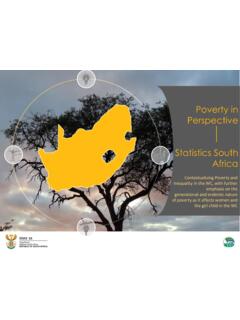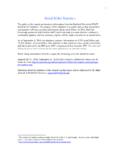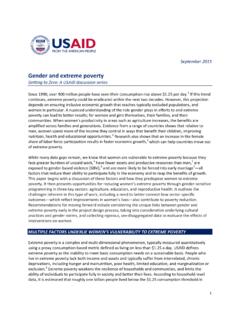Transcription of The Failing Standard of Basic Education in South Africa
1 In South Africa there are many signs that show that there is a crisis in Education . With high enrolment rates each year, and increasingly poor grade 12 output, it is clear that more concentration needs to be focused on the quality of Education . Quantity should, however, also be considered when the majority of those learners who pass matric do not meet the minimum requirements for university entrance. In addition, of the number of learners enrolled in grade 1, only half make it to grade 12. It has been established that a number of factors or problems hinder learners from receiving a good Standard of Education . These include: parents lack of participation in their children s Education and the weak functioning of School Governing Bodies (SGBs). SGBs were formed in all South African public schools to oversee the administration of the schools, but they are often sidelined due to the lack of formal Education and training of members, especially in the area of finance and general administration of the school.
2 Good leadership in schools is also needed to make sure that teachers attend to their classes diligently and learners take the importance of Education seriously. Government needs to ensure that teachers are trained accordingly and schools have adequate Basic resources. This paper will discuss these factors that have been identified as causing the drop in the Standard of Education in South Africa , and some recommendations will be made to improve this untenable situation. 1 Africa Institute of South Africa AISA POLICY brief Number 72 March 2012111 Brenda Matshidiso Modisaotsile is a Research Intern in the Unit of Knowledge Transfer and Skills Dvelopment at the Africa Institute of South INSTITUTE OF South Africa BRIEFINg NO 72 MARCH 2012only for ensuring that the citizenry are well educated; but also for human development and for the maintenance of socially responsive economic and political systems.
3 Despite the fact that South Africa has reached MDG2 and spends 18,5 per cent of its annual budget on Education , the Education system remains largely in a poor state of In fact, over the past five years the country has seen a IntroductionAn educated population remains the fundamental platform for meeting most of the other Millennium Developmental Goals (MDGs), and a well-oiled Education system is important for many reasons. It is a means to encourage a knowledge movement which reflects the traditional heritage of South Africa and develops it into a living force for the future. A good Education system is crucial, not The Failing Standard of Basic Education in South Africa Brenda Matshidiso Modisaotsile12 AISA POLICY brief Number 72 March 2012 Africa Institute of South Africaemployment and to create job opportunities for themselves and others.
4 Annual National Assessments (ANAs) for Grade 3 and 6 learners have found low levels of literacy and numeracy for South African learners. Without secure foundations of literacy and numeracy, our learners will never obtain the high- level skills needed by a nation to address poverty and inequality for development and The assessments found that only 35 per cent of learners can read, with results ranging from 12 per cent in Mpumalanga to a high of 43 per cent in the Western South Africa s Standard of educationIn her press release statement for the Annual National Assessment for 2011, the Minister of Basic Education , Mrs Angie Motshekga, stated at the Southern and Eastern African Consortium for Monitoring Education Quality (SACMEQ) that the results of 2007 had shown some improvement in reading since 2003, but not in She further indicated her concern over the Standard of South African Education by stating: This is worrying precisely because the critical skills of literacy and numeracy are fundamental to further Education and achievement in the worlds of both Education and work.
5 Many of our learners lack proper foundations in literacy and numeracy and so they struggle to progress in the system and into post-school Education and training .10 National Planning Minister Trevor Manuel, also found in his ministry s diagnostic overview (June 2011) that the quality of schooling is sub- Standard , especially in the township doubling of the Education budget to ZAR165, 1 billion, but still the system has failed to reverse unacceptably low exam results or to improve the Standard of The quality of Education remains very poor, and the output rate has not improved. Furthermore, classrooms are still overcrowded: the ratio of teachers to learners is 1:32 in South African public The dropout rate is very high, and literacy and numeracy levels are low.
6 Other challenges include: poor teacher training; unskilled teachers; lack of commitment to teach by teachers; poor support for learners at home; and a shortage of resources in Education despite the large budgetary commitments by government. It is clear, based on the facts, that there is a need to improve the quality and functionality of Education . Within this context there is also a need to place emphasis on the human rights of learners, which guarantee the right to Education and protect them against any disciplinary action that might be harmful to them. Enrolment rateAccording to statistics , South Africa has attained almost universal access to primary It is thus clear that this is not where the problem lies, as over 98 per cent of South African children attend and NumeracyIt is accepted that literate and educated people are better situated to obtain decent formal Source: statistics South Africa , General Household Surveys 2002 Africa Institute of South Africa AISA POLICY brief Number 72 March 2012 Violence in schools remains a key issue.
7 The rape of schoolgirls and sexual violence and abuse, often by teachers, has been a marked feature of the schooling experience of many boys as well as girls. Sexual abuse, pregnancy and poverty are factors increasing the drop-out rate in second-ary Mbuyisi Mgibisa mentions that the South African Institute of Race Relations has also expressed concern about the high dropout rate, especially in poor black The report states that of the 920 716 pupils in Grade 11 in 2007; only 64 per cent went on to take their Senior Certificate examination in The poor stand-ards have also been exacerbated by a large num-ber of under-qualified or unqualified teachers who teach in overcrowded and ill-equipped classrooms, with severely limited It should be noted that good school performance is linked to the participation of all stakeholders in Education .
8 These stakeholders include parents, teachers, learners, SGBs, government departments, and the private sector. It is therefore submitted that building relationships of mutualism among the stakeholders in Education will improve the quality of Education . Parents There are many good reasons why parents should be involved in their child s Education . One of the reasons is the ratio of teacher to learner in schools. One classroom teacher and 25 to 35 young minds to educate can be a very difficult task to The ratio of learners to teachers is too high, and although it is difficult to acknowledge, some learners simply fall through the cracks in the system. Parents are the safety net for their children, yet too many of them fail to realise this important fact. The greatest resource any classroom teacher can utilise is the The question is: What can parents do to help their children develop in conjunction with the efforts of the formal Education system?
9 The one simple thing that parents can do to assist in the formal Education of their child is to take an interest in all aspects of their child s school activities: academic projects, extra-curricular activities and relationships. This means helping them with their homework and knowing what they are doing in class. It means getting them involved in school sports teams, music, drama, clubs, and so on. Finally it means knowing whom their child interacts with, how he or she interacts with others, and whether they need parental direction that can and will be Parents have a fundamental responsibility to ensure that their children are at school and their homework is done. Unfortunately, many parents have never attended school themselves, and so do not know how to read, write and count properly.
10 Nevertheless, the more parents participate in the schooling of their children, in a sustainable way, at every level: in advocacy, decision making and oversight roles, as fundraisers and boosters, as volunteers and para-professionals, and as home teachers, the better for learner parents work long hours; and when they get home they are often too tired or unmotivated to ensure that their children s homework is done properly. Other parents do the homework for their children; which does not help them or show them how it must be done, so the child will not learn how to find the right answers. A study conducted by Feinstein and Symons found that a very high parental interest in a learner s Education is associated with better exam results. Children whose parents show little or no interest are low who are well informed on policies and resource allocation in the Education sector, and involved in decision making regarding their children, can exert considerable influence and contribute solutions to the challenges in the Education Involved communities are able to articulate local school needs, hold officials accountable and mobilise local resources to fill gaps when government response is not All communities should value Education for their children.







